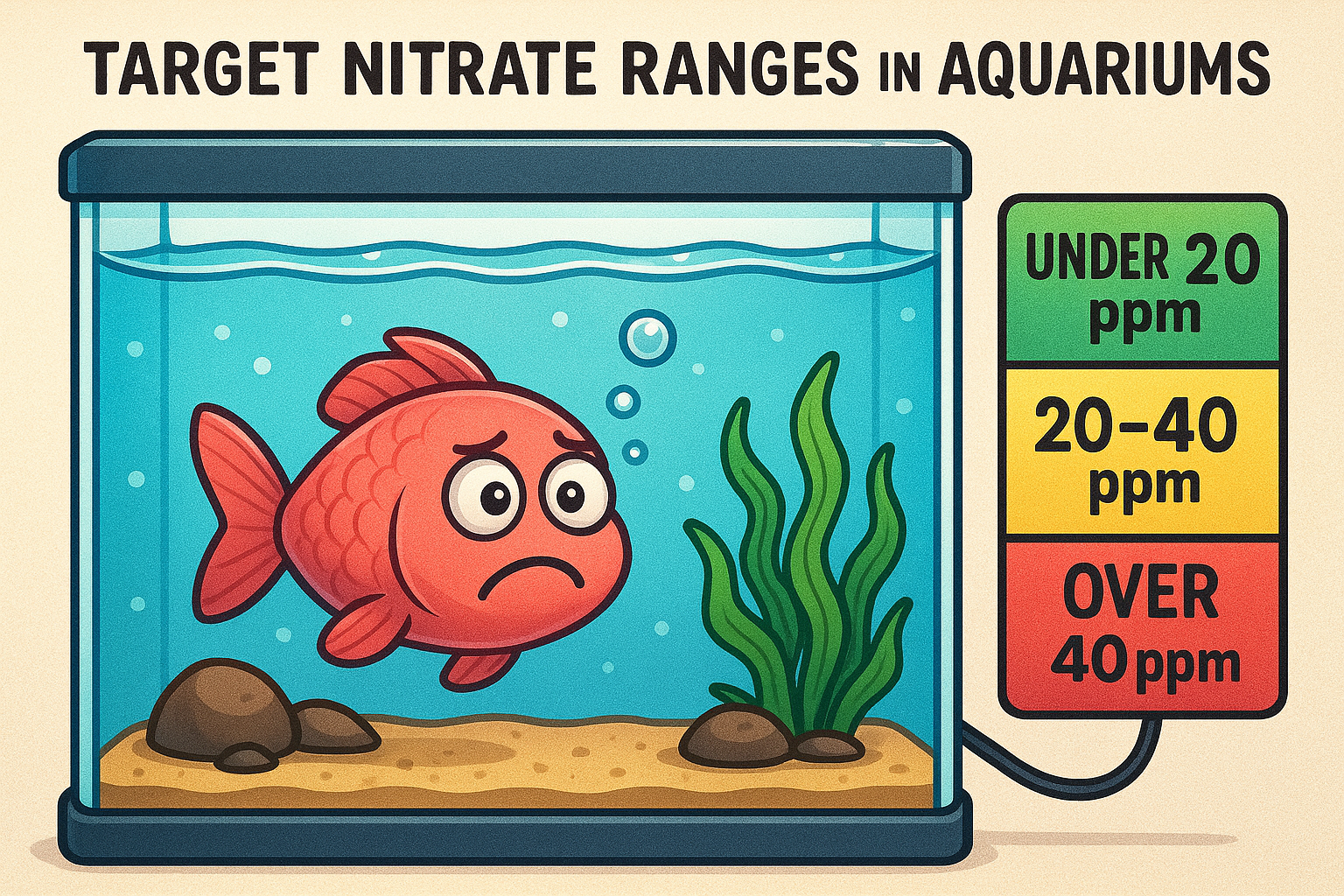Nitrate Targets (NO₃⁻) — by System & Goal
🎯 Nitrate Targets (NO₃⁻) — by System & Goal
Legend: ✅ ideal • ⚠️ watch • 🚫 avoid
🐠 Freshwater community (tetras, barbs, corys)
- ✅ ≤20 ppm
- ⚠️ 20–40 ppm (okay short-term for hardy fish)
- 🚫 >40 ppm (chronic stress ↑ disease)
🐟 Sensitive / wild-caught (discus, wild plecos, dwarf cichlids)
- ✅ ≤10–15 ppm (aim for ≤10 if you can)
- ⚠️ 15–25 ppm
- 🚫 >25 ppm
🛡️ Stingrays & other nitrate-sensitive big fish
- ✅ ≤10 ppm (many ray keepers run 5–10)
- ⚠️ 10–20 ppm
- 🚫 >20 ppm
🐣 Breeding & fry grow-outs
- ✅ ≤5–10 ppm
- ⚠️ 10–20 ppm (fertility/egg survival may drop)
- 🚫 >20 ppm
🌿 High-tech planted FW (CO₂, EI/lean dosing)
- Plants need nitrate: keep 5–20 ppm steady
- If algae blooms: check PO₄, K, CO₂ balance before cutting NO₃ too low
🌊 Marine
- Fish-only (FOWLR): ✅ ≤20–40 ppm
- Mixed reef/LPS: ✅ 5–10 ppm
- SPS-dominant: ✅ 2–5 ppm (ultra-low risk of “zero nitrate starvation”)
🧠 Why these numbers matter (what nitrate does chronically)
- 🧪 Physiology: impairs osmoregulation and gill ion transport; raises metabolic/oxidative stress.
- 🩺 Immunity & disease: higher background mortality, slower healing; parasites/bacteria gain edge.
- 🧬 Reproduction: poorer gamete quality, egg/larval survival drops above ~20 ppm in many species.
- 🩸 Nitrite link: nitrate itself ≪ toxic than nitrite/ammonia, but dirty systems that run high NO₃ often have episodic NH₃/NO₂ spikes too.
📏 Units & testing you can trust
- Many kits report mg/L as NO₃⁻. Some lab meters report mg/L as N (NO₃-N).
- Convert: NO₃⁻ = 4.43 × NO₃-N
- ✅ Use a liquid kit/photometer; shake reagents vigorously (nitrate tests are notorious for under-mixing).
- 🧪 If reading off-scale, dilute the sample 1:1 or 1:4 with RO/DI and multiply back.
- 💧 Check tap water nitrate—if your source is 10–20 ppm, you’ll never hit low targets without RO/DI.
🛠️ How to stay under target (stack these)
💧 Water changes (most reliable)
- If new water nitrate = N_new, current tank nitrate = N_now, target = N_target
Required change fraction f: f=Nnow−NnewNnow−Ntarget (Example: N_now 60 → target 15, tap 5 ⇒ f = (60−15)/(60−5)=45/55=0.82 ⇒ 82% total change, done as 2–3 staggered changes to avoid swings in temp/TDS.)
🧼 Source & load control
- 🍽️ Right-size feeding (track grams/day; most tanks are overfed by 25–50%).
- 🧹 Mechanical export: prefilters, daily floss swaps; removes N before it mineralizes.
- ♻️ Deep-clean dead zones (sumps, hoses, under rocks) that leak nitrate back.
🌿 Assimilation: plants & algae
- FW: fast growers (hornwort, water sprite), floaters, pothos; give strong light + micronutrients so NO₃ is actually consumed.
- SW: refugium with chaeto or turf scrubber on reverse-light cycle.
🧫 Denitrification (true NO₃ removal)
- Anoxic media (sulfur denitrators, low-flow porous media) set up correctly.
- Carbon dosing (vodka/vinegar/NOPOX) for marine: powerful but monitor DO & skimmer—bacterial blooms can de-oxygenate water.
🚰 When source water has nitrate
- RO/DI + remineralization (FW) or salt mix (SW).
- Blend RO with tap to meet hardness while keeping NO₃ target reachable.
🧮 Planning cheat-sheet (rules of thumb)
- 📉 Weekly drop needed to hold a setpoint:
- If your system adds ~20 ppm/week, and your new water is ~0 ppm, a 50% weekly change holds you near ~10 ppm steady.
- 🐟 Stocking effect: doubling biomass roughly doubles weekly nitrate rise (same feeding style).
- 🌡️ Warm water → faster metabolism → faster NO₃ climb.
- 🧪 Trend beats snapshots: log ppm/week slope. If slope >5–10 ppm/week, add export capacity.
🚦 Action thresholds to run by (freshwater)
- 0–10 ppm: ideal for wild/sensitive, breeding, rays.
- 10–20 ppm: good for most setups; keep stable.
- 20–40 ppm: serviceable for hardy fish; schedule larger/export upgrades.
- >40 ppm: corrective action—big changes in stages + add real export.
🧯 Safe reduction protocol (when you’re high)
- Stage large changes (e.g., 40% today, 40% tomorrow) to avoid temp/TDS swings.
- Match temp/KH/GH closely; rays/discus are osmo-sensitive.
- Boost aeration during big cleanups (detritus release can sap O₂).
- Resume maintenance cadence based on your measured weekly nitrate slope.
📋 Quick targets you can post in the fish room
- Rays/Discus/Wild Loricariids: ≤10 ppm
- General FW communities: ≤20–30 ppm (hard cap 40)
- Planted high-tech: 5–20 ppm steady (don’t “0-out” NO₃)
- Marine FOWLR: ≤20–40 ppm
- Reef: 2–10 ppm (system-specific; avoid 0)

Powered by Lightspeed
Display prices in:USD